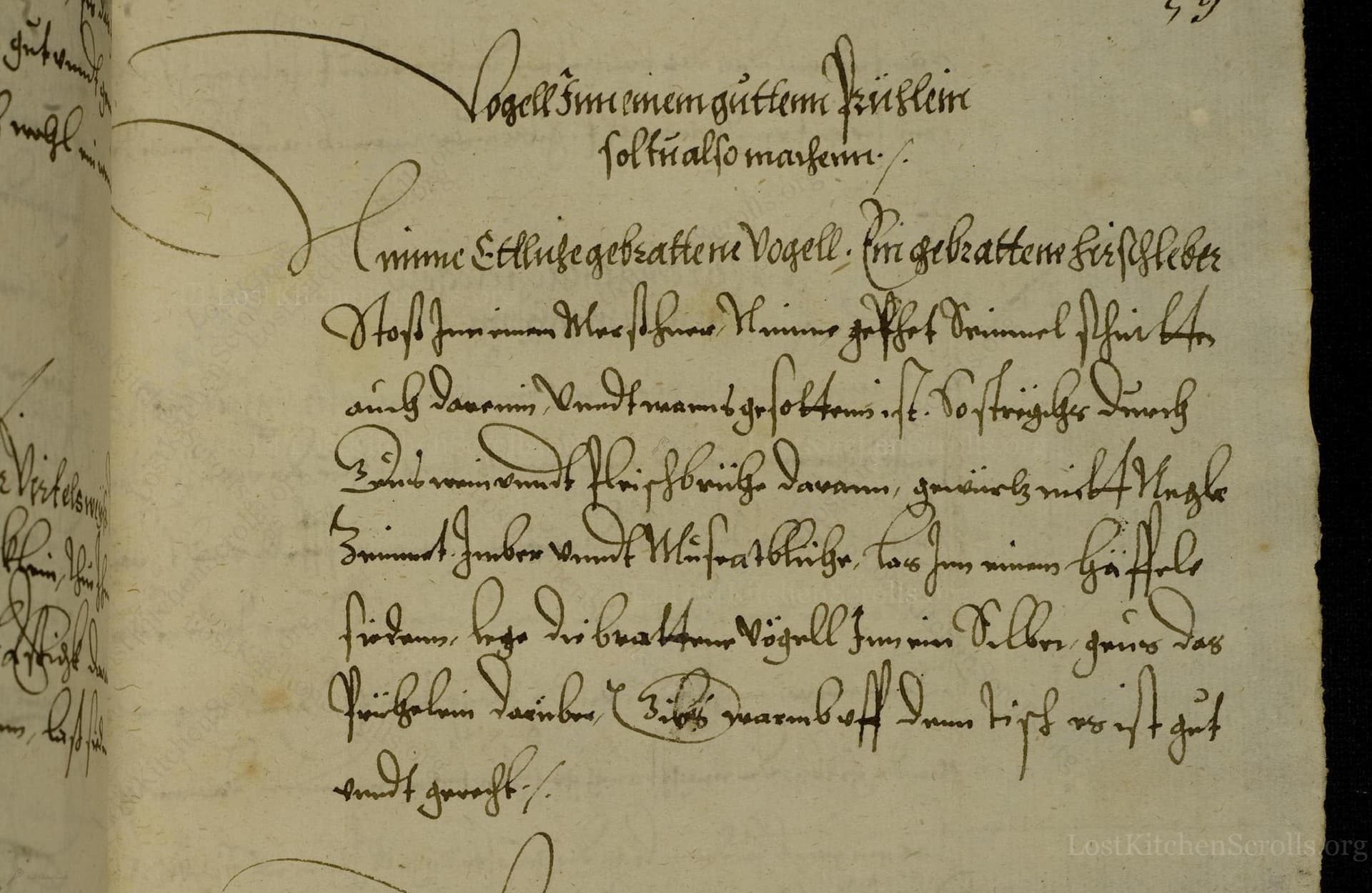Vogell Inn Einem Güttem Brüelein Solt Du Allso Machenn
"Birds In A Good Broth You Should Make Thus"
From the treasured pages of Kochbuch
Unknown Author

Vogell Inn Einem Güttem Brüelein Solt Du Allso Machenn
"Nimm Ettliche gebrattene Vogell. Inn gebrattem süesseleber stoß Inn einem Mörser Nimm pfeffer Vnnd saffran Vnd nimms so ob staus, ist so einigstes Vnnöt Vnd nimms so einigstes Davonn, gewürtz nicht zu starckh. Nimm Jmber vnnd Muscatblüe. lege Inn einem häffele sidenn. lege die brattene Vögell Inn ein Velber, geuss das Brüelein darüber. Laß warmb seÿn, Dann tischs es ist güt vnnd gewiss."
English Translation
"Birds in a good broth you should make as follows. Take several roasted birds. Pound roast calf's liver in a mortar. Take pepper and saffron, and add them as if it were dust; be sparing and add only a little, do not season too strongly. Take ginger and mace. Place [everything] in a small pot to boil. Place the roasted birds in a bowl, pour the broth over them. Let it be warm, then serve; it is good and certain."
Note on the Original Text
Like many German recipes of the Renaissance, this is written as a brief, narrative instruction—no step-by-step lists, approximate quantities, or defined times. Spelling is wildly variable and phonetic; words like 'gebrattem süesseleber' (roast sweet liver) and 'gründ nicht zu starckh' ('do not spice it too strongly') use regionally specific grammar and archaic spelling. Early recipes assumed an experienced cook who knew the basics and could fill in the gaps—amounts and techniques were left unsaid unless critical.

Title
Kochbuch (1570)
You can also click the book image above to peruse the original tome
Writer
Unknown
Era
1570
Publisher
Unknown
Background
A flavorful journey back to the last third of the 16th century in the Oberpfalz region, this cookbook serves up a delightful menu of Renaissance-era recipes and culinary wisdom—perfect for those who wish to feast like nobles of old.
Kindly made available by
Heidelberg, Universitätsbibliothek
This recipe hails from a 16th-century manuscript, compiled in the Oberpfalz region of modern Bavaria. At the time, cookbooks were treasured as much for their role in preserving family and courtly traditions as for practical kitchen guidance. Birds like pigeon or songbirds were regular fare in well-off households, and offal such as liver was prized for its richness. The use of saffron and spices reflects social status—such luxuries would showcase both wealth and connections.

The original cook would have used a mortar and pestle for pounding the liver smooth, likely with a wooden or stone mortar. Roasting was done in open hearths, either on spits or in pots suspended over coals. Cooking vessels would include earthenware or metal 'häffele' (small pots), and service would be in large serving bowls or trenchers.
Prep Time
15 mins
Cook Time
45 mins
Servings
2
We've done our best to adapt this historical recipe for modern kitchens, but some details may still need refinement. We warmly welcome feedback from fellow cooks and culinary historians — your insights support the entire community!
Ingredients
- 14–18 oz roasted pigeon, quail, or Cornish hen
- 2.5 oz chicken or goose liver (sweetbread is possible as alternative)
- 1/2 teaspoon ground black pepper
- a big pinch saffron threads
- a pinch ground ginger
- a pinch mace (or nutmeg flower, or substitute with ground nutmeg)
- 1 cup chicken or vegetable broth (as needed)
- Salt to taste (optional)
Instructions
- To recreate this subtly spiced bird dish, start by roasting a handful (about 14–18 oz) of small birds—pigeon, quail, or even Cornish hen are good modern substitutes.
- Meanwhile, prepare a delicate sauce by finely pounding about 2.5 oz of chicken or goose liver in a mortar or food processor until smooth.
- Stir in 1/2 teaspoon black pepper, a big pinch of saffron, and just a pinch of ground ginger, along with a pinch of mace (or nutmeg flower).
- Avoid heavy sesoning—the original insists on restraint.
- Gently warm this sauce with enough chicken stock (about 1 cup) to make it pourable but rich.
- Arrange your cooked birds in a serving dish, pour over the hot suace, and serve warm.
- This recipe shines in its warmth and simplicity—sumptuous yet gentle.
Estimated Calories
380 per serving
Cooking Estimates
Roasting the birds and blending the sauce takes a little time. Prepping the ingredients and making the sauce is quick, then you just roast and assemble everything. This dish serves about two people, and each serving has an average amount of calories for a special meal.
As noted above, we have made our best effort to translate and adapt this historical recipe for modern kitchens, taking into account ingredients nowadays, cooking techniques, measurements, and so on. However, historical recipes often contain assumptions that require interpretation.
We'd love for anyone to help improve these adaptations. Community contributions are highly welcome. If you have suggestions, corrections, or cooking tips based on your experience with this recipe, please share them below.
Join the Discussion
Rate This Recipe
Dietary Preference
Main Ingredients
Occasions

Den Bockfisch In Einer Fleisch Suppen Zu Kochen
This recipe hails from a German manuscript cookbook compiled in 1696, a time whe...

Die Grieß Nudlen Zumachen
This recipe comes from a rather mysterious manuscript cookbook, penned anonymous...

Ein Boudain
This recipe comes from an anonymous German-language manuscript cookbook from 169...

Ein Gesaltzen Citroni
This recipe, dating from 1696, comes from an extensive anonymous German cookbook...
Browse our complete collection of time-honored recipes



